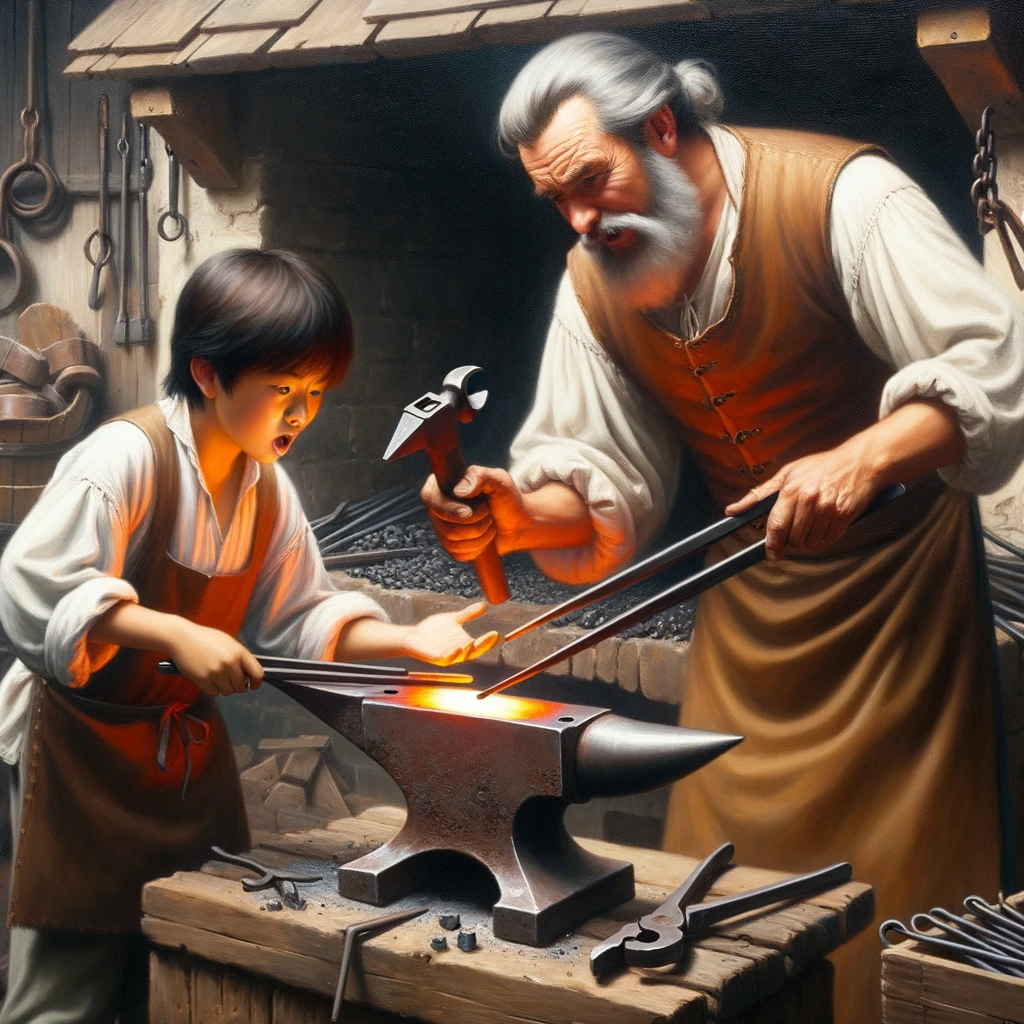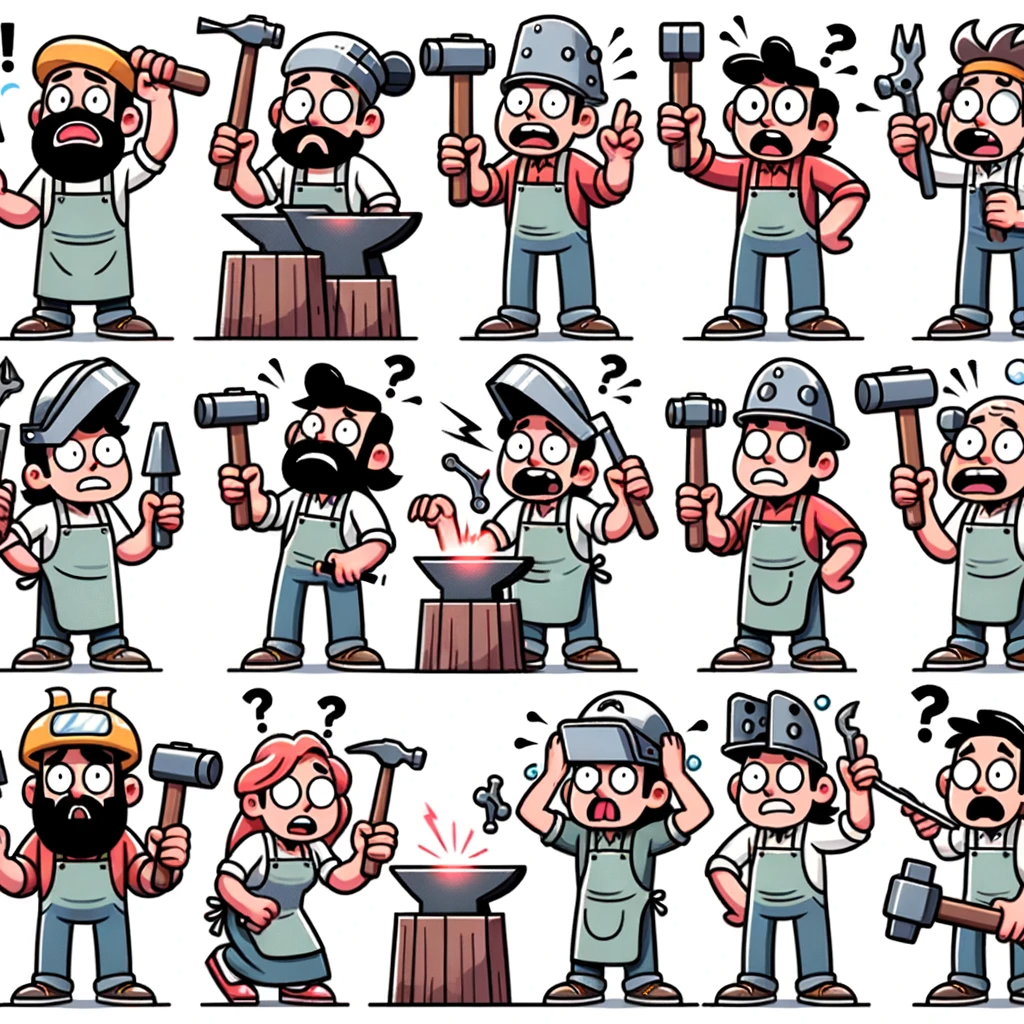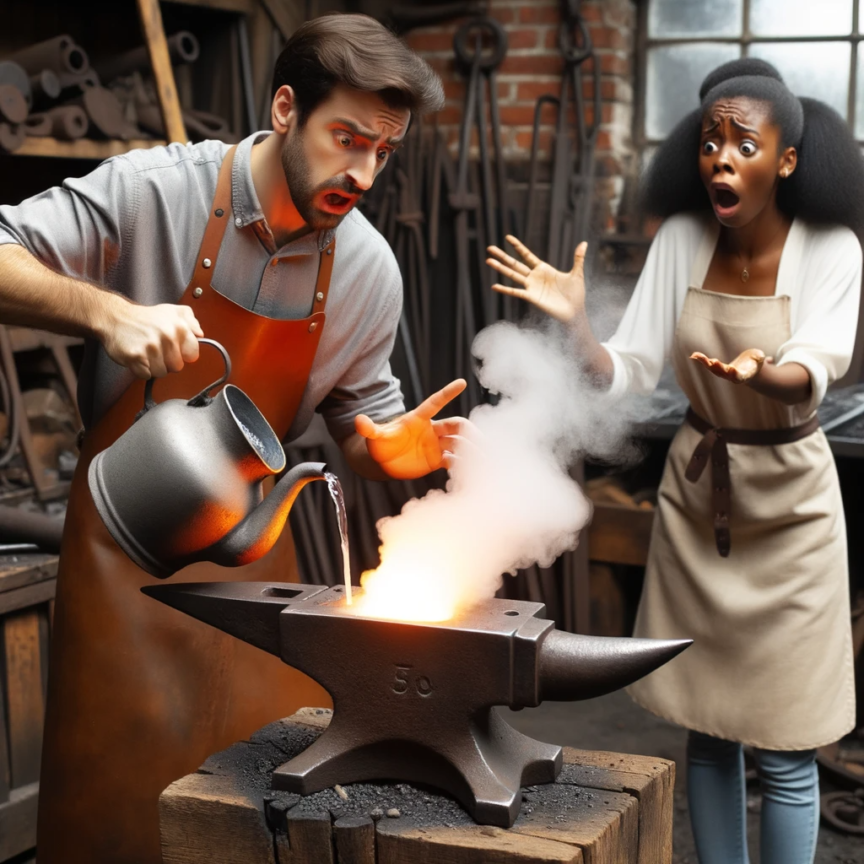Hey there! So, you’ve decided to jump into the world of blacksmithing, huh?
That’s awesome!
It’s such a cool and creative hobby to pick up.
But just like any new skill, there’s some common slip-ups that a lot of newbies tend to make. I even made some of these beginner blacksmith mistakes myself back in the day! So I can say from experience that I’ve been there.
In this article, I’m going to walk you through the top 10 mistakes that beginner blacksmiths make, and teach you how to avoid them. Whether you’re looking to make your first knife, some cool metal art, or just your first nail. Being aware of these common mistakes will make your blacksmithing journey start off a lot smoother.
1. Buying all the expensive equipment upfront
I get it, you’re super pumped to start blacksmithing.
Whenever I start any new hobby, I think I need all the fanciest and greatest gadgets right away.
But trust me, you don’t need to spend a fortune to get started with blacksmithing. The only basics you need are a basic forge, anvil, hammer, and some tongs. You can even DIY some of these or buy them used.
In the beginning, it’s best to focus on learning the basics. There’s plenty of time for fancy tools later. Besides, you might damage them at first when you’re learning to use them anyway.
2. Not getting your metal hot enough
This one’s super important! If your metal isn’t hot enough, it’s like trying to bend a spoon with your mind – it’s just not gonna happen. Metal that isn’t heated enough is hard to shape, which means it requires more force. That can lead to uneven results.
You want your metal a nice bright orange or yellow, so it’s easy to shape. Don’t be shy with the heat.
You might be hesitant to work with glowing hot metal. But trust me, when it comes to blacksmithing, the hotter the better.

3. Not developing a rhythm
Blacksmithing is like a dance between you, your tools, and the metal.
If you’re all over the place, it’s going to show in your work.
Find your groove, get into a steady rhythm, and you’ll find your blacksmithing becomes a whole lot smoother and more fun.
Find the right pace for you between the swing of your hammer, the position of your metal, and the heat of the forge.
When you lack rhythm, your strikes can become erratic. That means your metal will end up unevenly shaped and potentially damaged.
You want every hit with your hammer to be controlled and with a purpose.
It takes time and practice to develop a blacksmith’s rhythm, but it’s an important part of mastering the craft.
4. Having a disorganized workspace
A messy workspace is a no-go, especially with blacksmithing.
You need to know where your tools are at all times, and you definitely don’t want to be tripping over stuff. Keep your space tidy, look after your tools, and you’re setting yourself up for success.
A disorganized workspace doesn’t just hurt your productivity. It can also be a safety hazard! There’s enough to worry about when working with hot metal, without having your tools strewn around or out of reach. So avoid this beginner blacksmith mistake and keep things organized.
You also don’t want to be tripping over misplaced equipment, or burning yourself on hot metal that you didn’t realize was there.
Part of being organized also includes regular maintenance of your tools. Tools kept in good condition will last longer and be safer to use. Regularly check your hammers, tongs, and anvil for wear and damage, and address any issues as soon as you can.

5. Neglecting safety
While we’re having fun, we also need to stay safe. Blacksmithing comes with a good amount of sparks flying around and heavy pieces of metal being swung or hit.
It’s important to remember that you’ve only got one set of eyes, ears, and lungs, so we’ve gotta protect them like the precious treasures that they are.
Throwing on safety goggles, ear muffs, and a respirator might seem like a bit of a hassle, but trust me, it’s a small price to pay to keep ourselves in top-notch condition.
Those goggles will be your best friends against any stray sparks or tiny bits of metal, and the ear protection? That’s going to save your hearing from the constant clang and bang in the workshop. And let’s not forget the respirator, especially if you’re working with any funky metals or creating a cloud of dust. That’s why not working safely is one of the biggest beginner blacksmith mistakes that you can make.
I know, I know, we all like to think we’re invincible, especially when we’re just starting out. But even the seasoned pros will tell you: this safety gear? Non-negotiable. So, let’s gear up and make sure we’re looking out for ourselves, ensuring we have many more awesome years of blacksmithing ahead of us!
6. Wearing gloves during machining
On the topic of safety, we know that personal protective equipment (PPE) is super important. But there are also times where things like gloves can actually cause more harm than good, especially around machines like lathes and drill presses.
Gloves might feel like they’re offering an extra layer of protection. But if they get caught in a machine’s rotating parts, it can be seriously bad news, and potentially lead to some really nasty injuries.
So instead of relying on gloves for these situations, let’s focus on making sure all the safety guards are in place, and we’re not wearing anything that could get caught up in the machinery.
7. Not taking breaks
Let’s not forget that blacksmithing is very physical and difficult work. There’s a lot of heat and hammering involved. And that means we need to make sure we’re taking breaks to stay sharp and keep our energy up.
When we’re in the zone, forging away, it’s easy to forget just how hot and intense it can get in the workshop. But trust me, taking a step back every now and then to grab some water and cool down is key. We don’t want to get so caught up in the work that we end up tired, dehydrated, and making other beginner blacksmith mistakes. That’s just asking for trouble.
8. Not planning out your projects
It might seem like you can just wing it and figure things out as you go, but trust me, having a game plan will make everything run much more smoothly. So before you jump into your next big blacksmithing project, it’s important to take some time and plan.
Forging metal requires clear and well-thought-out planning, since many aspects of the process are time sensitive. Once your metal is heated, there’s a limited window of opportunity where it’s malleable and able to be worked. Knowing exactly what you’re going to do next helps to not waste any of this precious time.
So, let’s take a little time before we start, map out what we’re going to do, and make sure we’ve got everything we need right at hand. Trust me, it’s going to make our blacksmithing adventure so much more enjoyable and rewarding. Let’s plan it out and nail it!

9. Starting off with a hammer that’s too heavy
Blacksmithing is a surprisingly good workout, and it can work muscle groups that you’re probably not used to using in your everyday life.
A lot of beginners don’t realise this, and pick up a hammer that’s way too heavy for them.
If your arms and wrists aren’t used to it, this can cause all kinds of aches, pains, and even injuries. Plus it makes it harder to accurately hit the metal.
It’s way better to start small. Pick a lighter hammer, get your technique down, and build up those blacksmithing muscles gradually. This way, you can work on getting your hits just right and avoid tiring yourself out too quickly. As you get stronger and more comfortable, you can start using bigger hammers. Trust me, your body will thank you for it!
10. Putting your thumb on the hammer’s handle
When you’re hammering away, it might feel natural to rest your thumb on top of the hammer’s handle. But here’s the thing: that’s actually not so great for your wrist. Blacksmithing means a lot of repetitive motion, and the wrong technique can really do a number on your body over time.
Instead, try keeping your thumb along the side of the handle. It might feel a bit weird at first, but it lines everything up better and helps prevent strains and injuries. Remember, you want to be swinging from your shoulder and elbow, not just flicking your wrist. Plus, getting the right technique down is key to making sure your hits are precise and effective. Practice makes perfect, so keep at it and your blacksmithing (and your wrists) will be better for it!
11. Starting on too large of a project
Don’t bite off more than you can chew when you’re just getting started.
It’s easy to get carried away dreaming about making some epic sword or intricate gate. But diving into huge projects right away can leave you feeling overwhelmed and bummed out. Big projects are tricky and require a lot of know-how.
Start with something small and manageable. For example, try making a nail. It’s a great way to learn the basics without getting in over your head. Plus, finishing smaller projects gives you a nice confidence boost and helps you build up to the big, complex stuff. As you get better and more confident, you can start taking on bigger challenges. Remember, blacksmithing is a journey, not a race!
12. Improper ventilation
Working with hot metal can release some nasty gases, especially if you’re using coal or gas forges.
Without good ventilation, you could be breathing in harmful stuff like carbon monoxide, and that’s really bad news.
Make sure your workspace has plenty of fresh air flowing through. This might mean installing fans, vents, or even just cracking open a window. It’s not just about getting rid of the bad air; you’ve got to make sure there’s plenty of clean air coming in too. Keep an eye on your air quality and make adjustments as needed to keep things safe. Your lungs will thank you!
Conclusion
Blacksmithing is a bit of a learning curve, and every newbie is bound to mess up here and there.
But hey, that’s how you learn and get better!
In this article, we’ve talked about some common beginner blacksmith mistakes and how to dodge them.
Just remember, blacksmithing is an art that takes time, patience, and a whole lot of practice. Stay aware of these little pitfalls, keep learning and asking for advice, and you’ll have a blast working the forge. So, gear up, stay safe, and get ready to make some sparks fly in your blacksmithing adventure!


